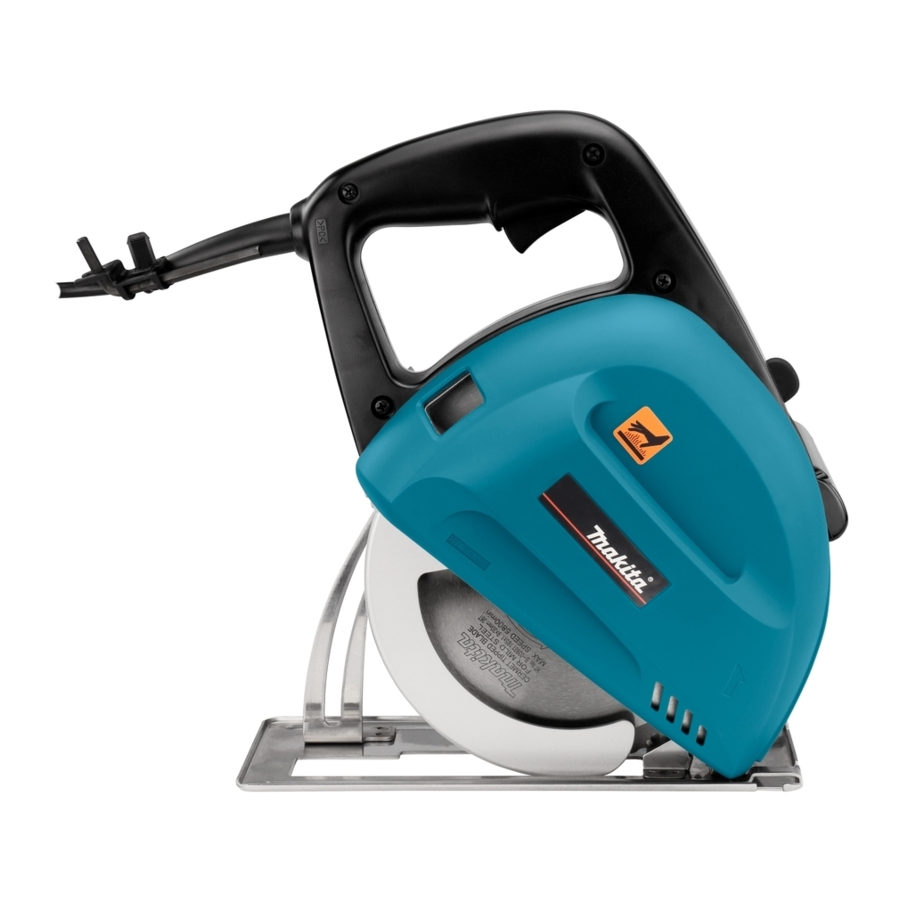Makita 4131 Instrukcja obsługi - Strona 4
Przeglądaj online lub pobierz pdf Instrukcja obsługi dla Elektronarzędzie Makita 4131. Makita 4131 12 stron. Metal cutter
Również dla Makita 4131: Instrukcja obsługi (14 strony), Instrukcja obsługi (12 strony), Instrukcja obsługi (12 strony), Instrukcja obsługi (12 strony)

21. Keep cutting tools sharp and clean. Properly
maintained cutting tools with sharp cutting edges
are less likely to bind and are easier to control.
22. Use the power tool, accessories and tool bits
etc. in accordance with these instructions and in
the manner intended for the particular type of
power tool, taking into account the working con-
ditions and the work to be performed. Use of the
ADDITIONAL SAFETY RULES FOR TOOL
DANGER:
1.
Keep hands away from cutting area and the
blade. Keep your second hand on auxiliary han-
dle, or motor housing. If both hands are holding
the tool, they cannot be cut by blade.
2.
Do not reach underneath the workpiece. The
guard cannot protect you from the blade below the
workpiece.
3.
Adjust the cutting depth to the thickness of the
workpiece. Less than a full tooth of the blade teeth
should be visible below the workpiece.
4.
Never hold piece being cut in your hands or
across your leg. Secure the workpiece to a sta-
ble platform. It is important to support the work
properly to minimize body exposure, blade binding,
or loss of control.
A typical illustration of proper hand support, workpiece
support, and supply cord routing (if applicable).
5.
Hold power tool by insulated gripping surfaces
when performing an operation where the cutting
tool may contact hidden wiring or its own cord.
Contact with a "live" wire will also make exposed
metal parts of the power tool "live" and shock the
operator.
6.
When ripping always use a rip fence or straight
edge guide. This improves the accuracy of cut and
reduces the chance of blade binding.
7.
Always use blades with correct size and shape
(diamond versus round) of arbour holes. Blades
that do not match the mounting hardware of the tool
will run eccentrically, causing loss of control.
8.
Never use damaged or incorrect blade washers
or bolt. The blade washers and bolt were specially
4
power tool for operations different from those
intended could result in a hazardous situation.
Service
23. Have your power tool serviced by a qualified
repair person using only identical replacement
parts. This will ensure that the safety of the power
tool is maintained.
designed for your tool, for optimum performance
and safety of operation.
9.
Causes and operator prevention of kickback;
•
Kickback is a sudden reaction to a pinched,
bound or misaligned saw blade, causing an
uncontrolled tool to lift up and out of the
workpiece toward the operator.
•
When the blade is pinched or bound tightly
by the kerf closing down, the blade stalls
and the motor reaction drives the unit rap-
idly back toward the operator.
•
If the blade becomes twisted or misaligned
in the cut, the teeth at the back edge of the
blade can dig into the top surface of the
workpiece causing the blade to climb out of
the kerf and jump back toward the operator.
Kickback is the result of tool misuse and/or
incorrect operating procedures or conditions
and can be avoided by taking proper precau-
tions as given below.
a.
Maintain a firm grip with both hands on the
tool and position your arms to resist kick-
back forces. Position your body to either
side of the blade, but not in line with the
blade. Kickback could cause the tool to jump
backwards, but kickback forces can be control-
led by the operator, if proper precautions are
taken.
b.
When blade is binding, or when interrupting
a cut for any reason, release the trigger and
hold the tool motionless in the material until
the blade comes to a complete stop. Never
attempt to remove the tool from the work or
pull the tool backward while the blade is in
motion or kickback may occur. Investigate
and take corrective actions to eliminate the
cause of blade binding.
c.
When restarting a tool in the workpiece,
centre the saw blade in the kerf and check
that saw teeth are not engaged into the
material. If saw blade is binding, it may walk up
or kickback from the workpiece as the tool is
restarted.
ENB082-3
